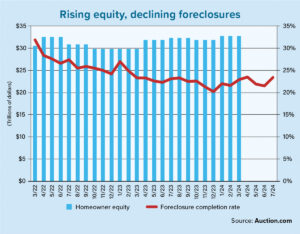Thirty to 60 days. That’s how long the average mortgage approval can take, according to Realtor.com. In some cases, it can take even longer. For mortgage originators, these delays can increase costs by extending rate locks or forcing applications to be reprocessed, adding administrative expenses and hurting relationships with borrowers, which could lead to lost business and reputational damage.
These delays remain a persistent challenge for mortgage originators in terms of cost, borrower satisfaction and financial stability. There is a clearer pathway for mortgage originators to streamline and improve operations so they can enjoy shorter closings and improved relations with their clients and referral partners. Finding this pathway lies in identifying the areas of the business that are eating into time and costs, the challenges creeping in around archaic processes, legacy systems and dated platforms. Doing so can give you an edge in the competitive mortgage market.
“If companies want to meet shorter closing times, they need to remove duplication, refine processes and remember one very important thing: People are the heart of this industry.”
Painstaking processes
One of the most common causes of lost time and error occurs due to the multiple teams or multiple people all working on one application or project. There are obviously steps every mortgage originator must take to ensure an application is compliant and runs smoothly, but when there are a lot of people working on one transaction, mistakes can be made — and these mistakes are costly in expenses and time.
Mistakes can add additional hours, days or even months to a borrower’s wait time, as mortgage originators will have to re-check documentation at every step of the process to identify the root cause of the mistake. Another challenge mortgage originators face lies in additional costs. Economic turmoil and inflation have made everything more expensive, resulting in the need for costs to be closely monitored to ensure services are streamlined and tightly managed.
It’s very easy for unexpected costs to slip in and add a lot of pressure to the bottom line. To prevent these additional costs, mortgage originators must identify what services are being duplicated, what systems can be optimized and what processes need to be refined to ensure costs can be sharpened and tightened. Although the process to go through every service provider and line item can be quite time-consuming, the cost savings will be significant over the long term.
This begs the question: Why are approaches not being refined completely? Instead of painstaking manual checking or outdated processes, companies could look to identify better systems with more efficient processes and review those on a regular basis.
If mortgage companies can see where they’ve lost time, they can sidestep the risks. For example, a verification of employment report costs about $60 for the initial run, and if mortgage originators run into incorrect information, those costs will double to run the report again.
These error-driven costs mean margins are down, volumes are down, rates are up and it’s hard to find balance. If companies want to meet shorter closing times, they need to remove duplication, refine processes and remember one very important thing: People are the heart of this industry.
Engineer efficiency
There are several ways to make closings more efficient. For one, being proactive at every step of the mortgage process, even looking at areas that are normally bypassed in a bid to save time or money, can fundamentally reimagine your processes and policies.
Take the time to make a friendly call to double-check client information, go through the application and verify the data points again. Engaging with the client is an inexpensive step that adds immense value to the level of service companies provide, and it will save them money. If they miss an employer on the initial application, they’re starting the process with an error.
It is a misstep that will increase operational expenses as a typo, misspelled name or incorrect address, for example, will incur additional delays and costs. Two to three days of repairing an error can cost several hundred dollars depending on the transaction.
When undertaking verifications, only verify the information needed at the time. Limit the amount of time emphasizing unnecessary information that doesn’t help the application, as this will reduce errors. Instead, use this time to check for errors again.
“Sales gets the accounts, but operations keep the accounts. … Dealing with money, managing time and recognizing clients have very real emotions are important parts of the process.”
Having a culture where every member of the team is focused on pushing a transaction through as quickly as possible can transform your approval speeds. A team that collaborates on verification, information double-checking, process management and borrower interactions is ultimately creating a more fluid operating environment that reduces errors and risks.
Everything must be intentional, whether it’s the steps and procedures that the team has not yet reviewed or the systems they’ve yet to modernize. Focus on intentional change that addresses legacy issues and bottlenecks, so every step is one taken toward a more agile and efficient operating environment.
Sales gets the accounts, but operations keep the accounts. Operational procedures such as dealing with money, managing time and recognizing clients have very real emotions are important parts of the process, each one a cog in the wheel. It’s essential to understand client needs and expectations and to be as accurate and focused as possible to achieve results.
Dated technology
Many companies remain entrenched in dated architecture and infrastructure. This isn’t because they’re resistant to technology, but rather that the inefficiencies in their processes haven’t come to light yet — or have only just started to show their impact on bottom lines and growth.
The inefficiencies and complexities inherent in older systems came to light in 2021. Home-price growth surged to a record that year, thanks to lower mortgage interest rates and the resulting demand from buyers wanting to take advantage of the market — demand that exceeded the system’s capacity.
Everything was pushed to stressed seams and delays were as much a part of the process as paperwork. It is a stark reminder that outdated processes and methodologies aren’t going to serve well in the next property boom.
Technology is a double-edged sword. It has changed the mortgage industry and makes it possible to achieve so much more within increasingly optimized systems. The human touch, however, remains key. While the industry wants the magic delivered by a robust customer relationship management (CRM) platform that can tell them what to do next, it’s never going to replace the invaluable relationship with a client.
Technology will always be beneficial, but its application should be intelligent — resolving the systemic or operational challenges within your business that minimize errors or complexity. The importance of human interaction is paramount, as this industry is filled with clients experiencing high emotions and intense stakes.
Clients need to know that they are in a safe pair of hands when they’re working with a mortgage originator to ensure a successful relationship and home closing. Additionally, a pair of hands that will get them over the line in a short closing time will not only make their lives easier, but also provide them with an experience that makes them feel like their application matters. ●
Author
-

Phil Crescenzo Jr. is vice president of the Southeast Division at Nation One Mortgage Corp. Crescenzo has over 20 years of industry experience helping homeowners, Realtors and building partners navigate the mortgage credit and approval process while making it easier to qualify. As a mortgage expert, Crescenzo constantly monitors market conditions and the changes in mortgage programs to provide financial guidance quickly and accurately. Crescenzo and his team have a background in a wide range of mortgage options.





